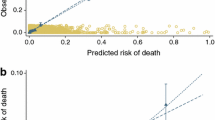Abstract
Four versions of Acute Physiology and Chronic Health Evaluation are limited in predicting hospital mortality for neurocritically ill patients. This prospective study aimed to develop and assess the accuracy of a modified APACHE II model in predicting mortality in neurologic intensive care unit (N-ICU). A total of 653 patients entered the study. APACHE II scores on admission, and worst 24-, 48-, and 72-h scores were obtained. Neurologic diagnoses on admission were classified into five categories: cerebral infarction, intracranial hemorrhage, neurologic infection, neuromuscular disease, and other neurologic diseases. We developed a modified APACHE II model based on the variables of the 72-h APACHE II score and disease category using a multivariate logistic regression procedure to estimate probability of death. We assessed the calibration and discrimination of the modified APACHE II model using the Hosmer–Lemeshow goodness-of-fit chi-squared statistic and area under the receiver operating characteristic curve (AU-ROC). The modified APACHE II model had good discrimination (AU-ROC = 0.88) and calibration (Hosmer–Lemeshow statistic: χ 2 = 3.707, P = 0.834). The discrimination of the 72-h APACHE II score for cerebral infarction, intracerebral hemorrhage, and neurologic infection was satisfactory, with AU-ROC of 0.858, 0.863, and 1.000, respectively, but it was poor in discriminating for the categories of other neurologic diseases and neuromuscular disease. The results showed that our modified APACHE II model can accurately predict hospital mortality for patients in N-ICU. It is more applicable to clinical practice than the previous model because of its simplicity and ease of use.


Similar content being viewed by others
Abbreviations
- APACHE:
-
Acute Physiology and Chronic Health Evaluation
- N-ICU:
-
Neurologic intensive care unit
- AU-ROC:
-
Area under the receiver operating characteristic curve
- ICU:
-
Intensive care unit
- ICH:
-
Intracerebral hemorrhage
- SAH:
-
Subarchnoid hemorrhage
- SDH:
-
Subdural hemorrhage
References
Knaus WA, Draper EA, Wagner DP, Zimmerman JE (1985) APACHE II: a severity of disease classification system. Crit Care Med 13:818–829
Zimmerman JE, Kramer AA, McNair DS, Malila FM (2006) Acute physiology and chronic health evaluation (APACHE) IV: hospital mortality assessment for today’s critically ill patients. Crit Care Med 34:1297–1310
Carson SS, Bach PB (2001) Predicting mortality in patients suffering from prolonged critical illness: an assessment of four severity-of-illness measures. Chest 120:928–933
Tan IK (1998) APACHE II and SAPS II are poorly calibrated in a Hong Kong intensive care unit. Ann Acad Med Singap 27:318–322
Diringer MN, Edwards DF (2001) Admission to a neurologic/neurosurgical intensive care unit is associated with reduced mortality rate after intracerebral hemorrhage. Crit Care Med 29:635–640
Su YY, Li HL, Cao GH, Wang DY, Liu JH, Wang XL (2008) The value of APACHE II to predict the outcome of the patients with severe neurologic diseases. Chin Neurology 41:258–261
Navarrete-Navarro Pedro, Rivera-Fernandez Ricardo, Lopez-Mutuberria Maria Teresa, Galindo Inmaculada, Murillo Francisco, Dominguez Jose Maria, Munoz Angeles, Jimenez-Moragas Jose Manuel, Nacle Belen, Vazquez-Mata Guillermo (2003) Outcome prediction in terms of functional disability and mortality at 1 year among ICU-admitted severe stroke patients: a prospective epidemiological study in the south of the European Union (Evascan Project, Andalusia, Spain). Intensive Care Med 29:1237–1244
Bhalla A, Gupta OP, Gupta SB (2002) Predicting mortality in stroke. Neurol India 50:279–281
Riachy M, Sfeir F, Sleilaty G, Hage-Chahine S, Dabar G, Bazerbachi T, Aoun-Bacha Z, Khayat G, Koussa S (2008) Prediction of the survival and functional ability of severe stroke patients after ICU therapeutic intervention. BMC Neurol 8:24
Rordorf G, Koroshetz W, Efird JT, Cramer SC (2000) Predictors of mortality in stroke patients admitted to an intensive care unit. Crit Care Med 28:1301–1305
Knaus WA, Wagner DP, Draper EA, Zimmerman JE, Bergner M, Bastos PG, Sirio CA, Murphy DJ, Lotring T, Damiano A (1991) The APACHE III prognostic system: risk hospitalized adults prediction of hospital mortality for critically ill. Chest 100:1619–1636
Acknowledgments
The study was supported by Capital Medical Research Development Foundation. The authors are grateful to Dr. Fang Xiang-Hua of the public and prevention department for support on statistics. The authors thank the medical editor in Medica Communicus Asia Network who edited the manuscript.
Conflict of interest statement
The authors declare that they have no competing interests.
Author information
Authors and Affiliations
Corresponding author
Rights and permissions
About this article
Cite this article
Su, YY., Li, X., Li, Sj. et al. Predicting hospital mortality using APACHE II scores in neurocritically ill patients: a prospective study. J Neurol 256, 1427–1433 (2009). https://doi.org/10.1007/s00415-009-5129-z
Received:
Revised:
Accepted:
Published:
Issue Date:
DOI: https://doi.org/10.1007/s00415-009-5129-z




